University Report: Lenovo's Innovative Marketing Strategies Analysis
VerifiedAdded on 2023/01/16
|26
|6285
|53
Report
AI Summary
This report, prepared for the BM6007 Innovative Marketing Strategies module, provides a comprehensive analysis of Lenovo's marketing strategies and product proposition. It begins with an executive summary highlighting the company's challenges in attracting a broader customer base and proposes a new marketing strategy. Part A delves into a critical evaluation of Lenovo's marketing approach, providing background information, a situation analysis covering segmentation, target customers, and the marketing mix (product, price, place, and promotion), and a competitive analysis, including Dell, HP, Acer, Xiaomi, Vivo, Oppo and Huawei. A PESTEL analysis examines the political, economic, social, technological, environmental, and legal factors influencing Lenovo's business. Part B outlines a strategic marketing plan, including marketing and financial objectives, a summary of the situation analysis, and proposed marketing strategies designed to position Lenovo's new launches effectively while balancing its premium and mass-market offerings. The report concludes with a summary of key findings and recommendations.
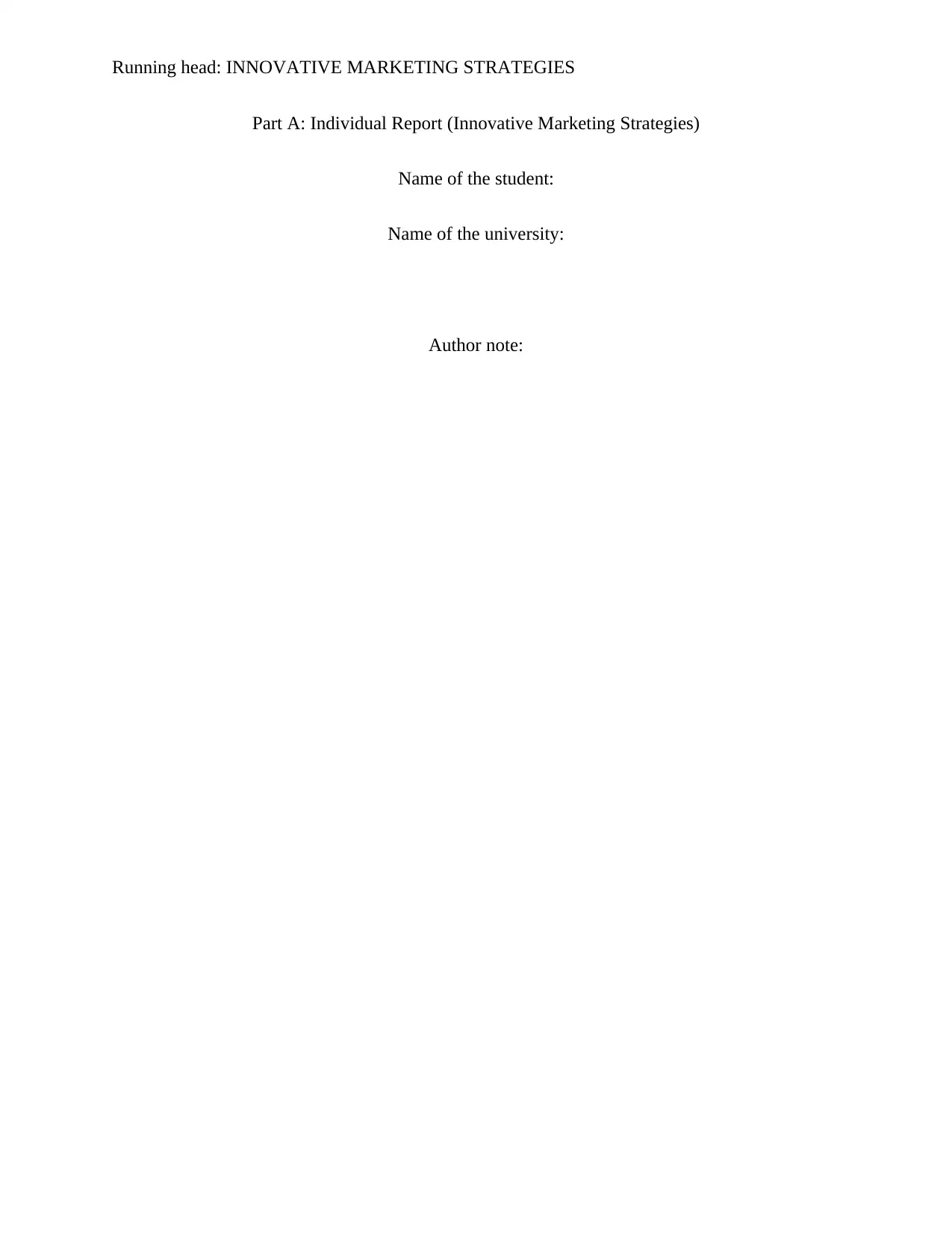
Running head: INNOVATIVE MARKETING STRATEGIES
Part A: Individual Report (Innovative Marketing Strategies)
Name of the student:
Name of the university:
Author note:
Part A: Individual Report (Innovative Marketing Strategies)
Name of the student:
Name of the university:
Author note:
Paraphrase This Document
Need a fresh take? Get an instant paraphrase of this document with our AI Paraphraser
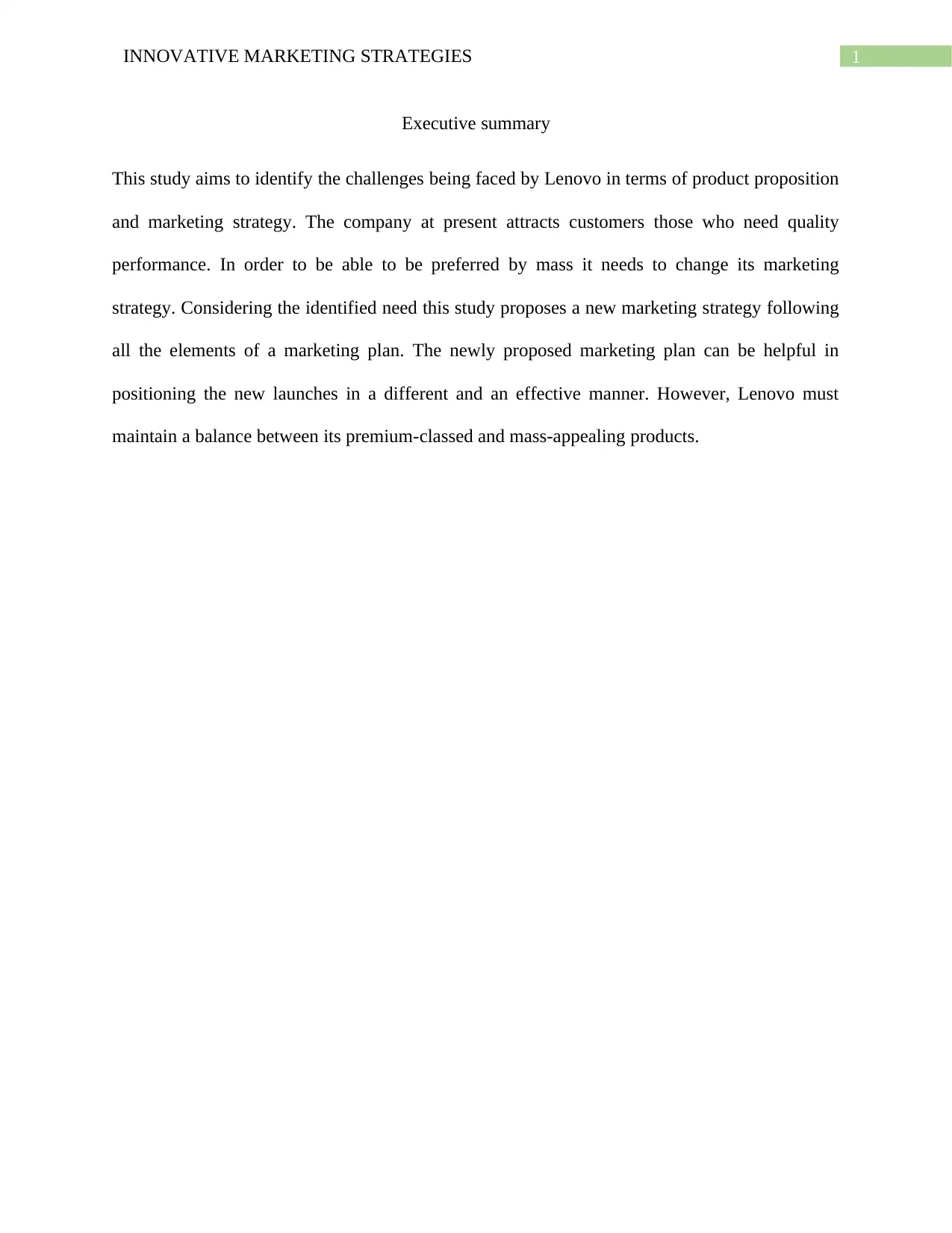
1INNOVATIVE MARKETING STRATEGIES
Executive summary
This study aims to identify the challenges being faced by Lenovo in terms of product proposition
and marketing strategy. The company at present attracts customers those who need quality
performance. In order to be able to be preferred by mass it needs to change its marketing
strategy. Considering the identified need this study proposes a new marketing strategy following
all the elements of a marketing plan. The newly proposed marketing plan can be helpful in
positioning the new launches in a different and an effective manner. However, Lenovo must
maintain a balance between its premium-classed and mass-appealing products.
Executive summary
This study aims to identify the challenges being faced by Lenovo in terms of product proposition
and marketing strategy. The company at present attracts customers those who need quality
performance. In order to be able to be preferred by mass it needs to change its marketing
strategy. Considering the identified need this study proposes a new marketing strategy following
all the elements of a marketing plan. The newly proposed marketing plan can be helpful in
positioning the new launches in a different and an effective manner. However, Lenovo must
maintain a balance between its premium-classed and mass-appealing products.
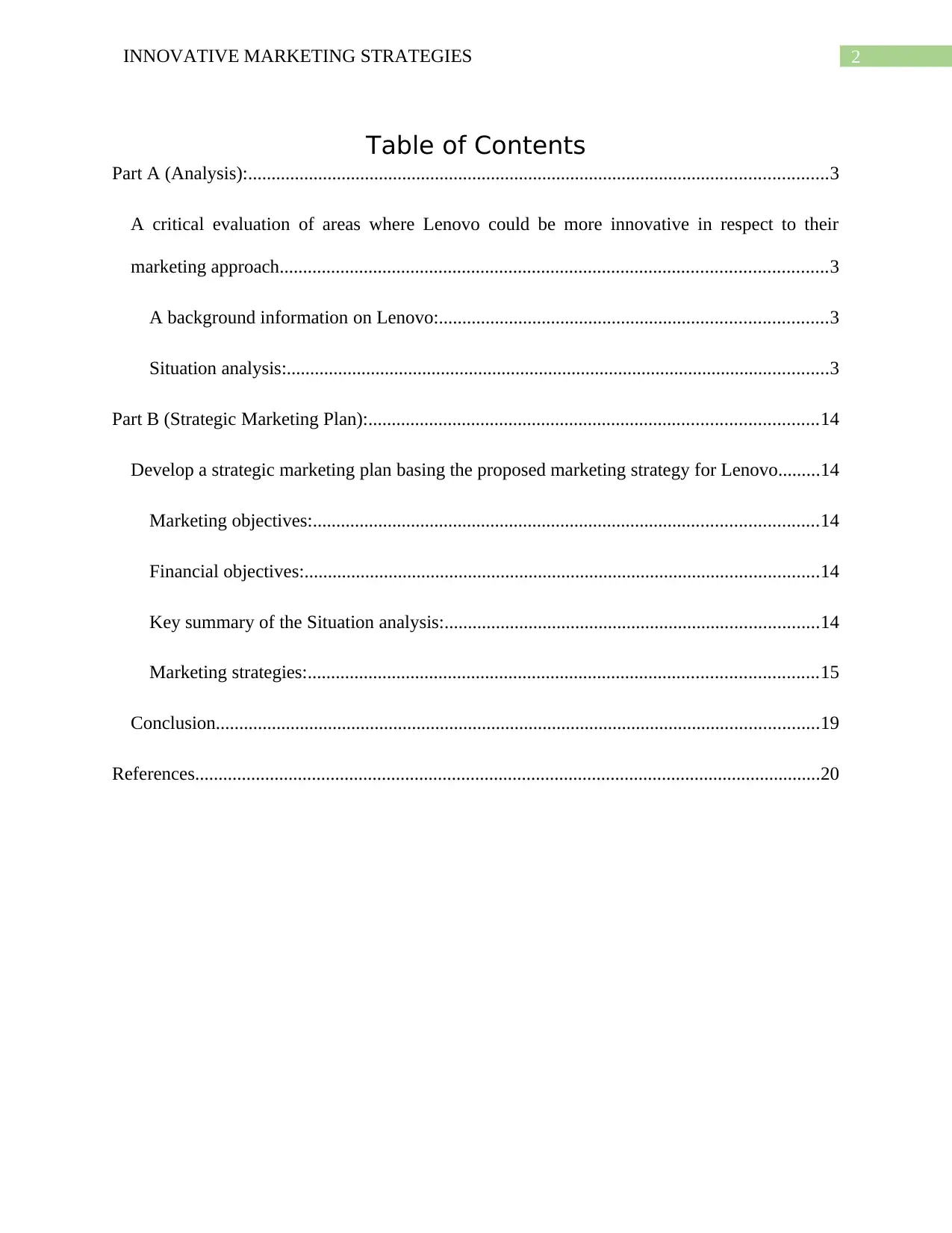
2INNOVATIVE MARKETING STRATEGIES
Table of Contents
Part A (Analysis):............................................................................................................................3
A critical evaluation of areas where Lenovo could be more innovative in respect to their
marketing approach.....................................................................................................................3
A background information on Lenovo:...................................................................................3
Situation analysis:....................................................................................................................3
Part B (Strategic Marketing Plan):................................................................................................14
Develop a strategic marketing plan basing the proposed marketing strategy for Lenovo.........14
Marketing objectives:............................................................................................................14
Financial objectives:..............................................................................................................14
Key summary of the Situation analysis:................................................................................14
Marketing strategies:.............................................................................................................15
Conclusion.................................................................................................................................19
References......................................................................................................................................20
Table of Contents
Part A (Analysis):............................................................................................................................3
A critical evaluation of areas where Lenovo could be more innovative in respect to their
marketing approach.....................................................................................................................3
A background information on Lenovo:...................................................................................3
Situation analysis:....................................................................................................................3
Part B (Strategic Marketing Plan):................................................................................................14
Develop a strategic marketing plan basing the proposed marketing strategy for Lenovo.........14
Marketing objectives:............................................................................................................14
Financial objectives:..............................................................................................................14
Key summary of the Situation analysis:................................................................................14
Marketing strategies:.............................................................................................................15
Conclusion.................................................................................................................................19
References......................................................................................................................................20
⊘ This is a preview!⊘
Do you want full access?
Subscribe today to unlock all pages.

Trusted by 1+ million students worldwide
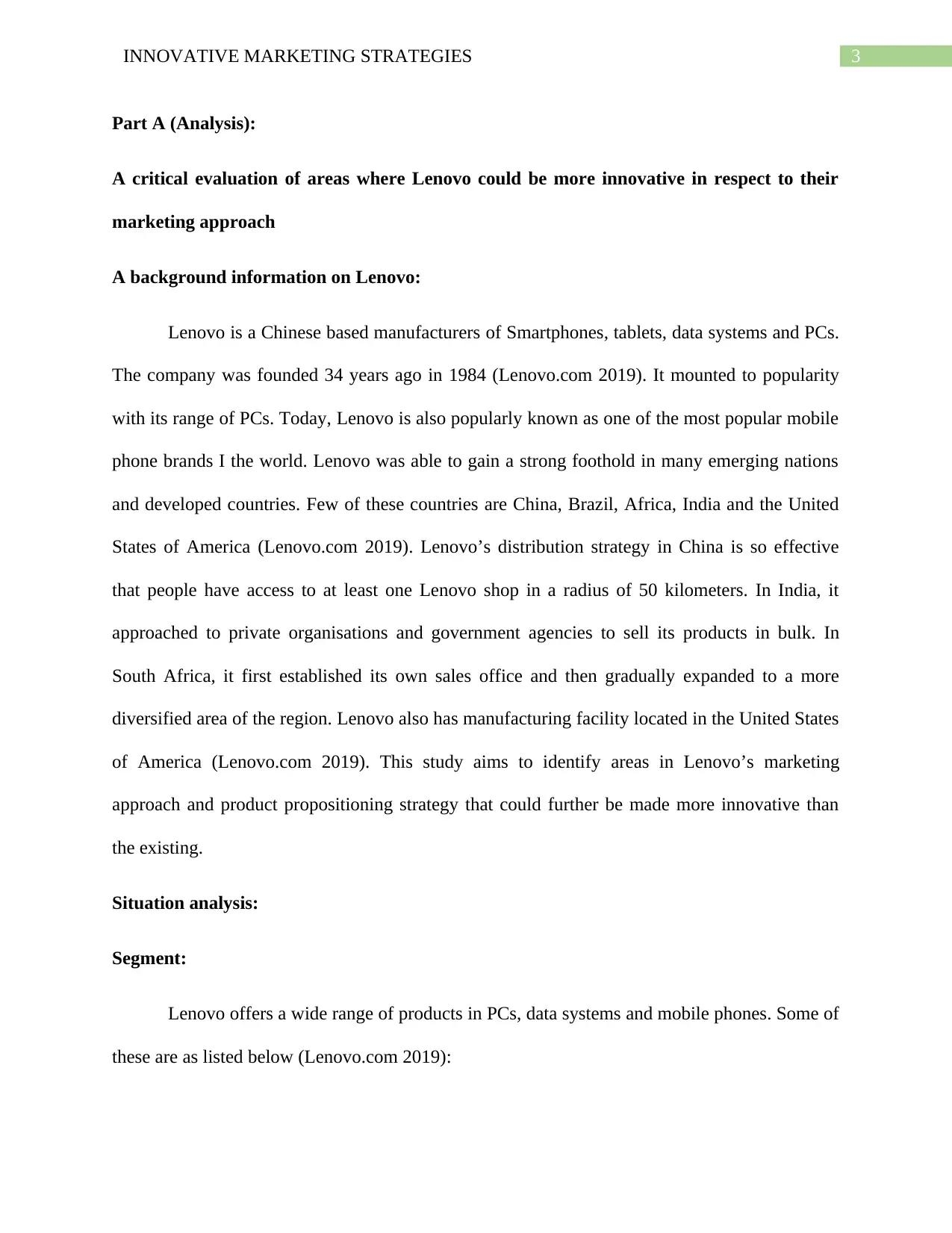
3INNOVATIVE MARKETING STRATEGIES
Part A (Analysis):
A critical evaluation of areas where Lenovo could be more innovative in respect to their
marketing approach
A background information on Lenovo:
Lenovo is a Chinese based manufacturers of Smartphones, tablets, data systems and PCs.
The company was founded 34 years ago in 1984 (Lenovo.com 2019). It mounted to popularity
with its range of PCs. Today, Lenovo is also popularly known as one of the most popular mobile
phone brands I the world. Lenovo was able to gain a strong foothold in many emerging nations
and developed countries. Few of these countries are China, Brazil, Africa, India and the United
States of America (Lenovo.com 2019). Lenovo’s distribution strategy in China is so effective
that people have access to at least one Lenovo shop in a radius of 50 kilometers. In India, it
approached to private organisations and government agencies to sell its products in bulk. In
South Africa, it first established its own sales office and then gradually expanded to a more
diversified area of the region. Lenovo also has manufacturing facility located in the United States
of America (Lenovo.com 2019). This study aims to identify areas in Lenovo’s marketing
approach and product propositioning strategy that could further be made more innovative than
the existing.
Situation analysis:
Segment:
Lenovo offers a wide range of products in PCs, data systems and mobile phones. Some of
these are as listed below (Lenovo.com 2019):
Part A (Analysis):
A critical evaluation of areas where Lenovo could be more innovative in respect to their
marketing approach
A background information on Lenovo:
Lenovo is a Chinese based manufacturers of Smartphones, tablets, data systems and PCs.
The company was founded 34 years ago in 1984 (Lenovo.com 2019). It mounted to popularity
with its range of PCs. Today, Lenovo is also popularly known as one of the most popular mobile
phone brands I the world. Lenovo was able to gain a strong foothold in many emerging nations
and developed countries. Few of these countries are China, Brazil, Africa, India and the United
States of America (Lenovo.com 2019). Lenovo’s distribution strategy in China is so effective
that people have access to at least one Lenovo shop in a radius of 50 kilometers. In India, it
approached to private organisations and government agencies to sell its products in bulk. In
South Africa, it first established its own sales office and then gradually expanded to a more
diversified area of the region. Lenovo also has manufacturing facility located in the United States
of America (Lenovo.com 2019). This study aims to identify areas in Lenovo’s marketing
approach and product propositioning strategy that could further be made more innovative than
the existing.
Situation analysis:
Segment:
Lenovo offers a wide range of products in PCs, data systems and mobile phones. Some of
these are as listed below (Lenovo.com 2019):
Paraphrase This Document
Need a fresh take? Get an instant paraphrase of this document with our AI Paraphraser
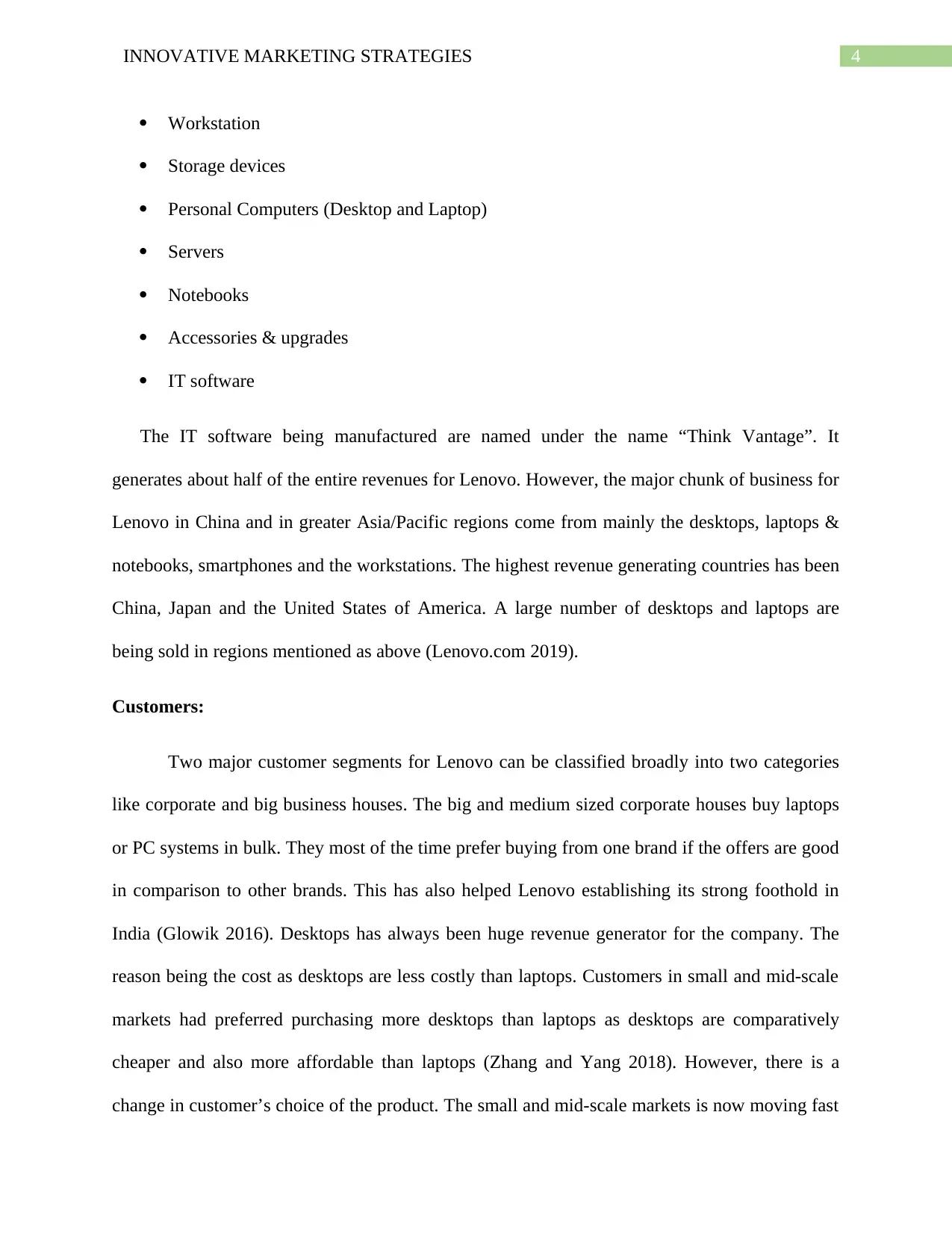
4INNOVATIVE MARKETING STRATEGIES
Workstation
Storage devices
Personal Computers (Desktop and Laptop)
Servers
Notebooks
Accessories & upgrades
IT software
The IT software being manufactured are named under the name “Think Vantage”. It
generates about half of the entire revenues for Lenovo. However, the major chunk of business for
Lenovo in China and in greater Asia/Pacific regions come from mainly the desktops, laptops &
notebooks, smartphones and the workstations. The highest revenue generating countries has been
China, Japan and the United States of America. A large number of desktops and laptops are
being sold in regions mentioned as above (Lenovo.com 2019).
Customers:
Two major customer segments for Lenovo can be classified broadly into two categories
like corporate and big business houses. The big and medium sized corporate houses buy laptops
or PC systems in bulk. They most of the time prefer buying from one brand if the offers are good
in comparison to other brands. This has also helped Lenovo establishing its strong foothold in
India (Glowik 2016). Desktops has always been huge revenue generator for the company. The
reason being the cost as desktops are less costly than laptops. Customers in small and mid-scale
markets had preferred purchasing more desktops than laptops as desktops are comparatively
cheaper and also more affordable than laptops (Zhang and Yang 2018). However, there is a
change in customer’s choice of the product. The small and mid-scale markets is now moving fast
Workstation
Storage devices
Personal Computers (Desktop and Laptop)
Servers
Notebooks
Accessories & upgrades
IT software
The IT software being manufactured are named under the name “Think Vantage”. It
generates about half of the entire revenues for Lenovo. However, the major chunk of business for
Lenovo in China and in greater Asia/Pacific regions come from mainly the desktops, laptops &
notebooks, smartphones and the workstations. The highest revenue generating countries has been
China, Japan and the United States of America. A large number of desktops and laptops are
being sold in regions mentioned as above (Lenovo.com 2019).
Customers:
Two major customer segments for Lenovo can be classified broadly into two categories
like corporate and big business houses. The big and medium sized corporate houses buy laptops
or PC systems in bulk. They most of the time prefer buying from one brand if the offers are good
in comparison to other brands. This has also helped Lenovo establishing its strong foothold in
India (Glowik 2016). Desktops has always been huge revenue generator for the company. The
reason being the cost as desktops are less costly than laptops. Customers in small and mid-scale
markets had preferred purchasing more desktops than laptops as desktops are comparatively
cheaper and also more affordable than laptops (Zhang and Yang 2018). However, there is a
change in customer’s choice of the product. The small and mid-scale markets is now moving fast
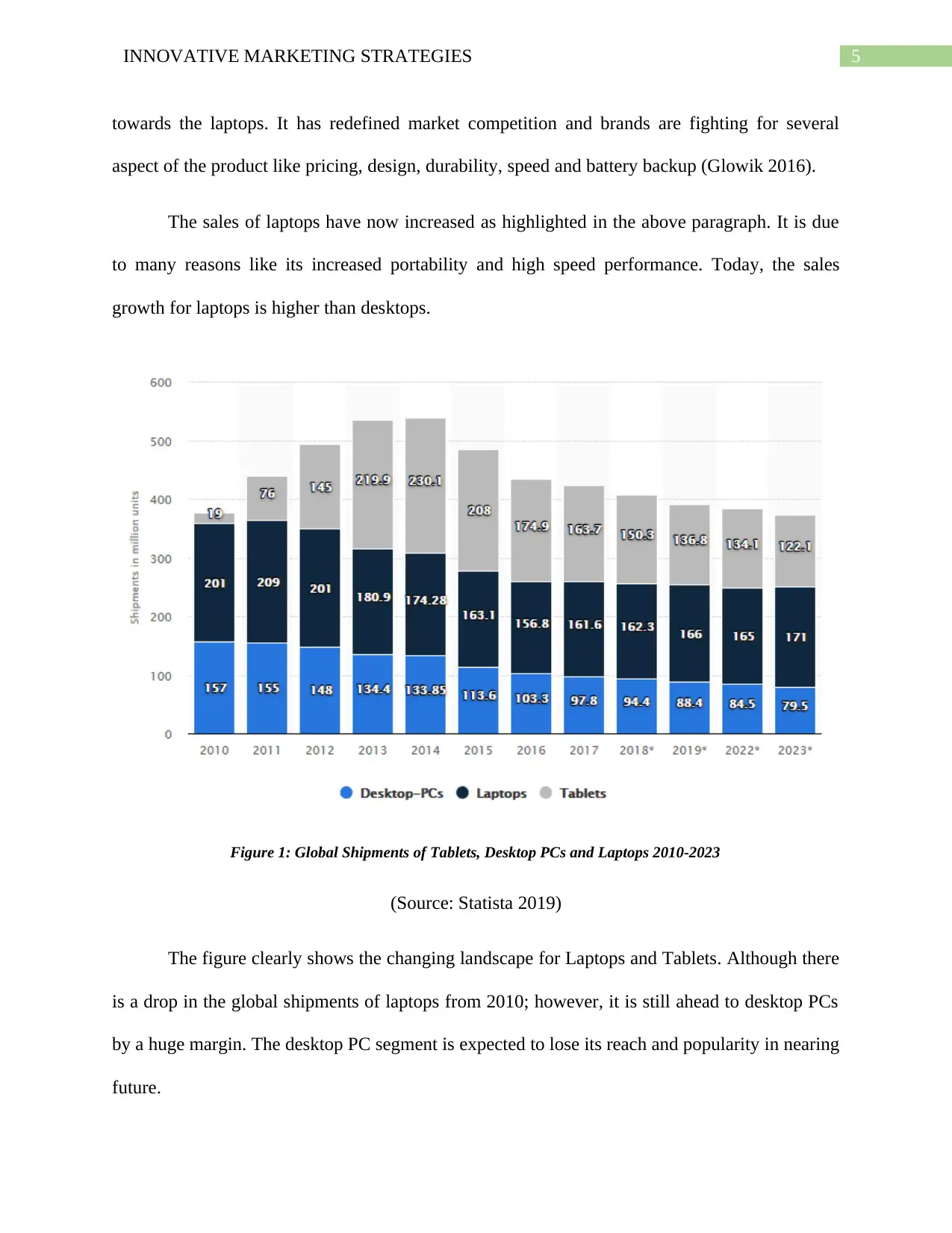
5INNOVATIVE MARKETING STRATEGIES
towards the laptops. It has redefined market competition and brands are fighting for several
aspect of the product like pricing, design, durability, speed and battery backup (Glowik 2016).
The sales of laptops have now increased as highlighted in the above paragraph. It is due
to many reasons like its increased portability and high speed performance. Today, the sales
growth for laptops is higher than desktops.
Figure 1: Global Shipments of Tablets, Desktop PCs and Laptops 2010-2023
(Source: Statista 2019)
The figure clearly shows the changing landscape for Laptops and Tablets. Although there
is a drop in the global shipments of laptops from 2010; however, it is still ahead to desktop PCs
by a huge margin. The desktop PC segment is expected to lose its reach and popularity in nearing
future.
towards the laptops. It has redefined market competition and brands are fighting for several
aspect of the product like pricing, design, durability, speed and battery backup (Glowik 2016).
The sales of laptops have now increased as highlighted in the above paragraph. It is due
to many reasons like its increased portability and high speed performance. Today, the sales
growth for laptops is higher than desktops.
Figure 1: Global Shipments of Tablets, Desktop PCs and Laptops 2010-2023
(Source: Statista 2019)
The figure clearly shows the changing landscape for Laptops and Tablets. Although there
is a drop in the global shipments of laptops from 2010; however, it is still ahead to desktop PCs
by a huge margin. The desktop PC segment is expected to lose its reach and popularity in nearing
future.
⊘ This is a preview!⊘
Do you want full access?
Subscribe today to unlock all pages.

Trusted by 1+ million students worldwide
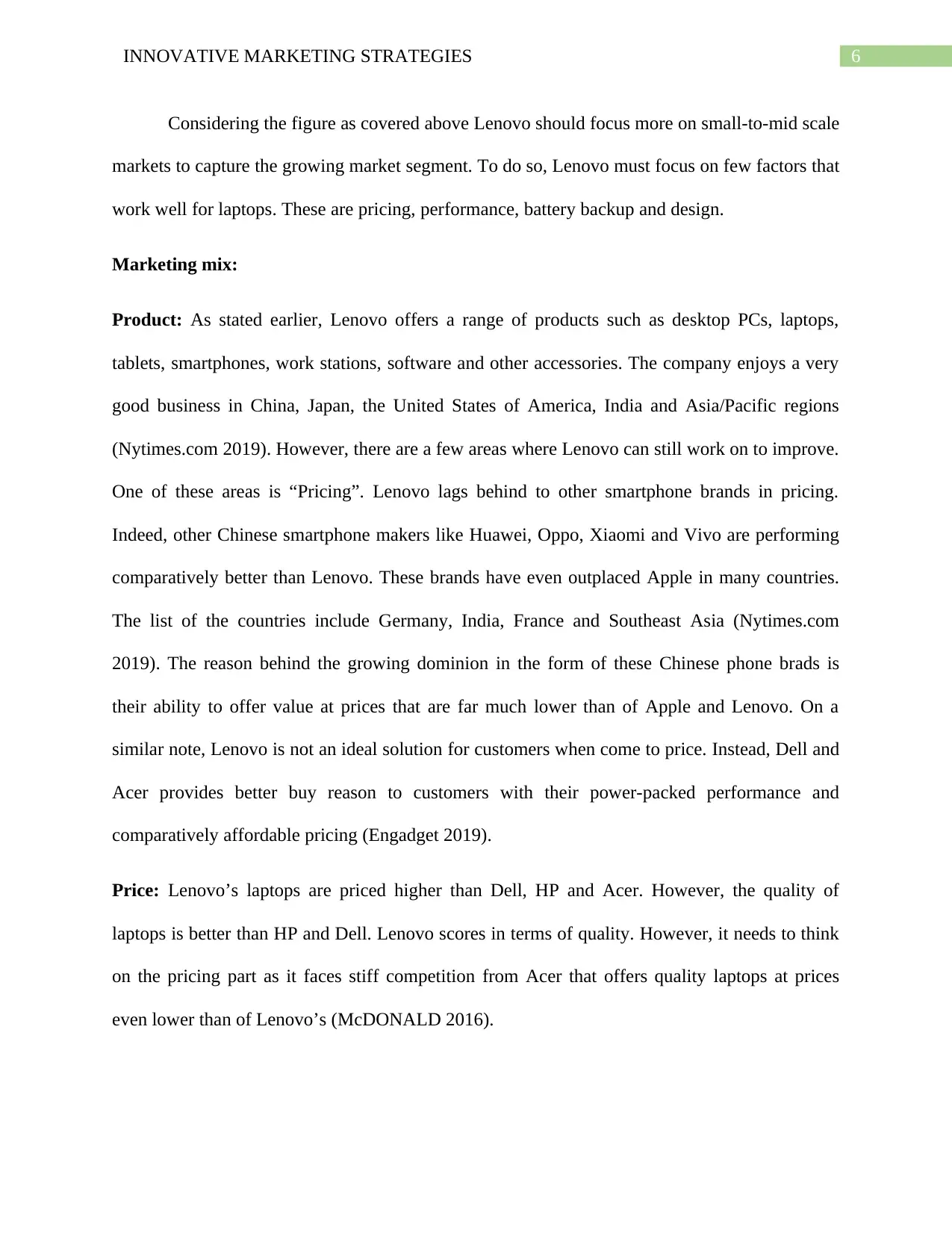
6INNOVATIVE MARKETING STRATEGIES
Considering the figure as covered above Lenovo should focus more on small-to-mid scale
markets to capture the growing market segment. To do so, Lenovo must focus on few factors that
work well for laptops. These are pricing, performance, battery backup and design.
Marketing mix:
Product: As stated earlier, Lenovo offers a range of products such as desktop PCs, laptops,
tablets, smartphones, work stations, software and other accessories. The company enjoys a very
good business in China, Japan, the United States of America, India and Asia/Pacific regions
(Nytimes.com 2019). However, there are a few areas where Lenovo can still work on to improve.
One of these areas is “Pricing”. Lenovo lags behind to other smartphone brands in pricing.
Indeed, other Chinese smartphone makers like Huawei, Oppo, Xiaomi and Vivo are performing
comparatively better than Lenovo. These brands have even outplaced Apple in many countries.
The list of the countries include Germany, India, France and Southeast Asia (Nytimes.com
2019). The reason behind the growing dominion in the form of these Chinese phone brads is
their ability to offer value at prices that are far much lower than of Apple and Lenovo. On a
similar note, Lenovo is not an ideal solution for customers when come to price. Instead, Dell and
Acer provides better buy reason to customers with their power-packed performance and
comparatively affordable pricing (Engadget 2019).
Price: Lenovo’s laptops are priced higher than Dell, HP and Acer. However, the quality of
laptops is better than HP and Dell. Lenovo scores in terms of quality. However, it needs to think
on the pricing part as it faces stiff competition from Acer that offers quality laptops at prices
even lower than of Lenovo’s (McDONALD 2016).
Considering the figure as covered above Lenovo should focus more on small-to-mid scale
markets to capture the growing market segment. To do so, Lenovo must focus on few factors that
work well for laptops. These are pricing, performance, battery backup and design.
Marketing mix:
Product: As stated earlier, Lenovo offers a range of products such as desktop PCs, laptops,
tablets, smartphones, work stations, software and other accessories. The company enjoys a very
good business in China, Japan, the United States of America, India and Asia/Pacific regions
(Nytimes.com 2019). However, there are a few areas where Lenovo can still work on to improve.
One of these areas is “Pricing”. Lenovo lags behind to other smartphone brands in pricing.
Indeed, other Chinese smartphone makers like Huawei, Oppo, Xiaomi and Vivo are performing
comparatively better than Lenovo. These brands have even outplaced Apple in many countries.
The list of the countries include Germany, India, France and Southeast Asia (Nytimes.com
2019). The reason behind the growing dominion in the form of these Chinese phone brads is
their ability to offer value at prices that are far much lower than of Apple and Lenovo. On a
similar note, Lenovo is not an ideal solution for customers when come to price. Instead, Dell and
Acer provides better buy reason to customers with their power-packed performance and
comparatively affordable pricing (Engadget 2019).
Price: Lenovo’s laptops are priced higher than Dell, HP and Acer. However, the quality of
laptops is better than HP and Dell. Lenovo scores in terms of quality. However, it needs to think
on the pricing part as it faces stiff competition from Acer that offers quality laptops at prices
even lower than of Lenovo’s (McDONALD 2016).
Paraphrase This Document
Need a fresh take? Get an instant paraphrase of this document with our AI Paraphraser
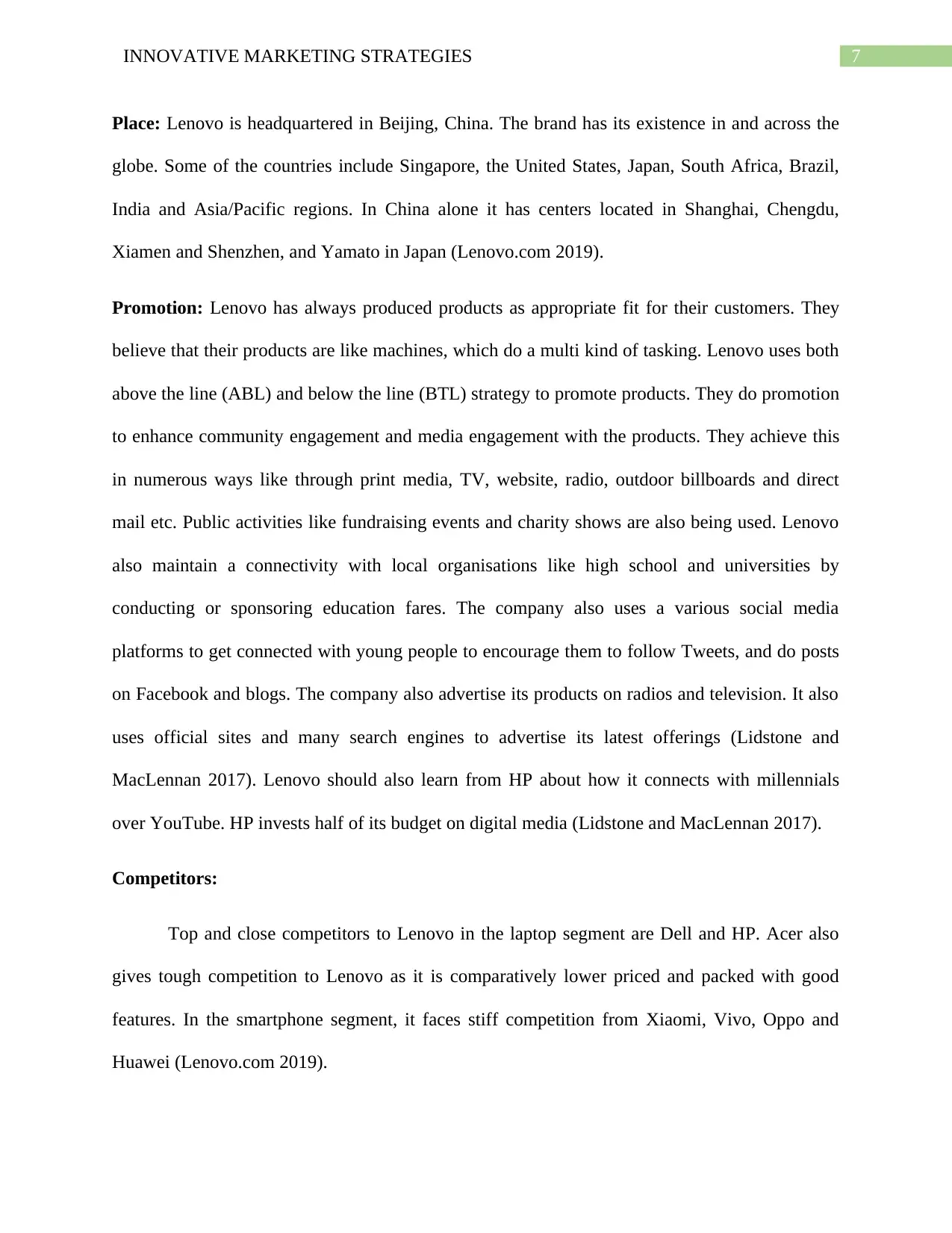
7INNOVATIVE MARKETING STRATEGIES
Place: Lenovo is headquartered in Beijing, China. The brand has its existence in and across the
globe. Some of the countries include Singapore, the United States, Japan, South Africa, Brazil,
India and Asia/Pacific regions. In China alone it has centers located in Shanghai, Chengdu,
Xiamen and Shenzhen, and Yamato in Japan (Lenovo.com 2019).
Promotion: Lenovo has always produced products as appropriate fit for their customers. They
believe that their products are like machines, which do a multi kind of tasking. Lenovo uses both
above the line (ABL) and below the line (BTL) strategy to promote products. They do promotion
to enhance community engagement and media engagement with the products. They achieve this
in numerous ways like through print media, TV, website, radio, outdoor billboards and direct
mail etc. Public activities like fundraising events and charity shows are also being used. Lenovo
also maintain a connectivity with local organisations like high school and universities by
conducting or sponsoring education fares. The company also uses a various social media
platforms to get connected with young people to encourage them to follow Tweets, and do posts
on Facebook and blogs. The company also advertise its products on radios and television. It also
uses official sites and many search engines to advertise its latest offerings (Lidstone and
MacLennan 2017). Lenovo should also learn from HP about how it connects with millennials
over YouTube. HP invests half of its budget on digital media (Lidstone and MacLennan 2017).
Competitors:
Top and close competitors to Lenovo in the laptop segment are Dell and HP. Acer also
gives tough competition to Lenovo as it is comparatively lower priced and packed with good
features. In the smartphone segment, it faces stiff competition from Xiaomi, Vivo, Oppo and
Huawei (Lenovo.com 2019).
Place: Lenovo is headquartered in Beijing, China. The brand has its existence in and across the
globe. Some of the countries include Singapore, the United States, Japan, South Africa, Brazil,
India and Asia/Pacific regions. In China alone it has centers located in Shanghai, Chengdu,
Xiamen and Shenzhen, and Yamato in Japan (Lenovo.com 2019).
Promotion: Lenovo has always produced products as appropriate fit for their customers. They
believe that their products are like machines, which do a multi kind of tasking. Lenovo uses both
above the line (ABL) and below the line (BTL) strategy to promote products. They do promotion
to enhance community engagement and media engagement with the products. They achieve this
in numerous ways like through print media, TV, website, radio, outdoor billboards and direct
mail etc. Public activities like fundraising events and charity shows are also being used. Lenovo
also maintain a connectivity with local organisations like high school and universities by
conducting or sponsoring education fares. The company also uses a various social media
platforms to get connected with young people to encourage them to follow Tweets, and do posts
on Facebook and blogs. The company also advertise its products on radios and television. It also
uses official sites and many search engines to advertise its latest offerings (Lidstone and
MacLennan 2017). Lenovo should also learn from HP about how it connects with millennials
over YouTube. HP invests half of its budget on digital media (Lidstone and MacLennan 2017).
Competitors:
Top and close competitors to Lenovo in the laptop segment are Dell and HP. Acer also
gives tough competition to Lenovo as it is comparatively lower priced and packed with good
features. In the smartphone segment, it faces stiff competition from Xiaomi, Vivo, Oppo and
Huawei (Lenovo.com 2019).
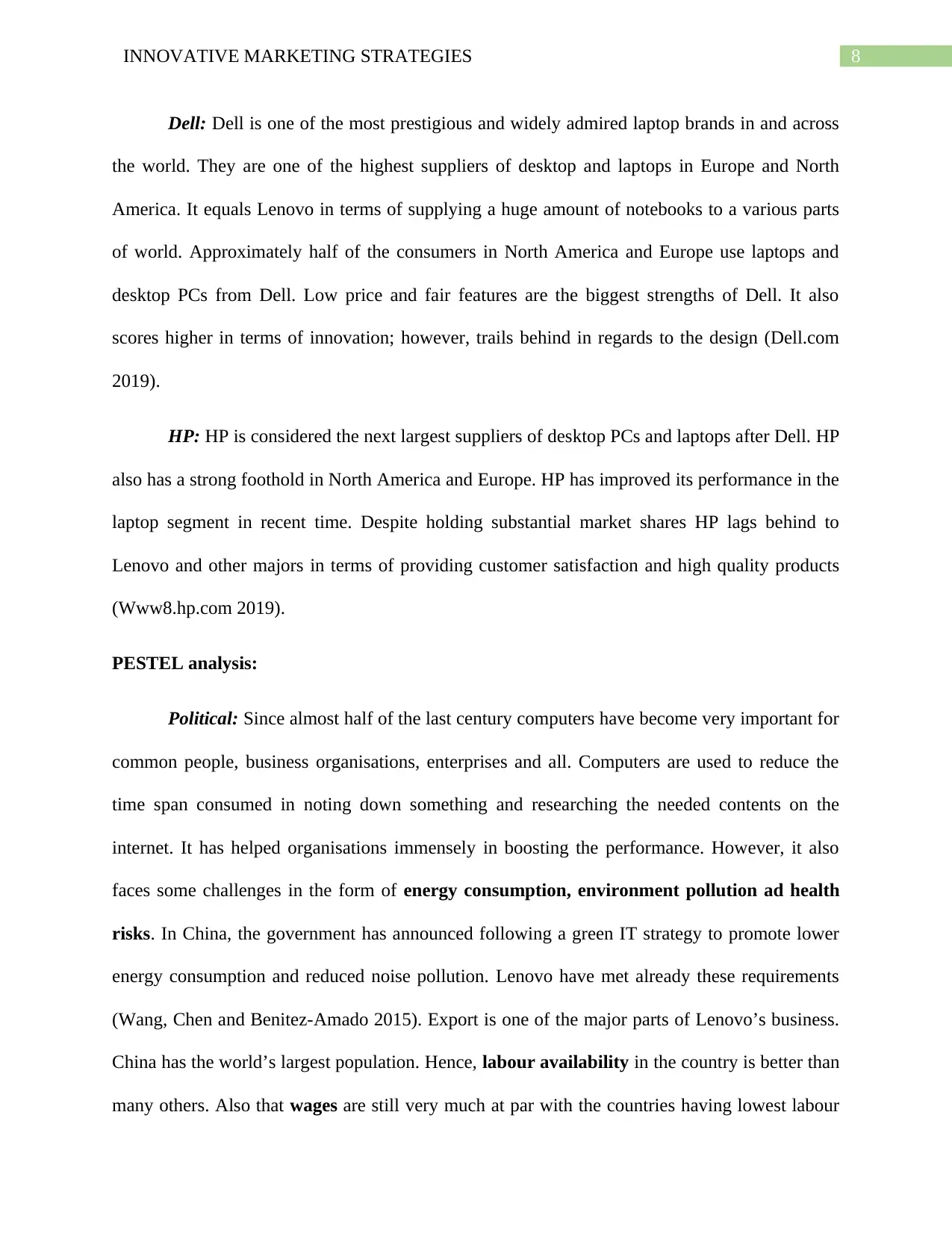
8INNOVATIVE MARKETING STRATEGIES
Dell: Dell is one of the most prestigious and widely admired laptop brands in and across
the world. They are one of the highest suppliers of desktop and laptops in Europe and North
America. It equals Lenovo in terms of supplying a huge amount of notebooks to a various parts
of world. Approximately half of the consumers in North America and Europe use laptops and
desktop PCs from Dell. Low price and fair features are the biggest strengths of Dell. It also
scores higher in terms of innovation; however, trails behind in regards to the design (Dell.com
2019).
HP: HP is considered the next largest suppliers of desktop PCs and laptops after Dell. HP
also has a strong foothold in North America and Europe. HP has improved its performance in the
laptop segment in recent time. Despite holding substantial market shares HP lags behind to
Lenovo and other majors in terms of providing customer satisfaction and high quality products
(Www8.hp.com 2019).
PESTEL analysis:
Political: Since almost half of the last century computers have become very important for
common people, business organisations, enterprises and all. Computers are used to reduce the
time span consumed in noting down something and researching the needed contents on the
internet. It has helped organisations immensely in boosting the performance. However, it also
faces some challenges in the form of energy consumption, environment pollution ad health
risks. In China, the government has announced following a green IT strategy to promote lower
energy consumption and reduced noise pollution. Lenovo have met already these requirements
(Wang, Chen and Benitez-Amado 2015). Export is one of the major parts of Lenovo’s business.
China has the world’s largest population. Hence, labour availability in the country is better than
many others. Also that wages are still very much at par with the countries having lowest labour
Dell: Dell is one of the most prestigious and widely admired laptop brands in and across
the world. They are one of the highest suppliers of desktop and laptops in Europe and North
America. It equals Lenovo in terms of supplying a huge amount of notebooks to a various parts
of world. Approximately half of the consumers in North America and Europe use laptops and
desktop PCs from Dell. Low price and fair features are the biggest strengths of Dell. It also
scores higher in terms of innovation; however, trails behind in regards to the design (Dell.com
2019).
HP: HP is considered the next largest suppliers of desktop PCs and laptops after Dell. HP
also has a strong foothold in North America and Europe. HP has improved its performance in the
laptop segment in recent time. Despite holding substantial market shares HP lags behind to
Lenovo and other majors in terms of providing customer satisfaction and high quality products
(Www8.hp.com 2019).
PESTEL analysis:
Political: Since almost half of the last century computers have become very important for
common people, business organisations, enterprises and all. Computers are used to reduce the
time span consumed in noting down something and researching the needed contents on the
internet. It has helped organisations immensely in boosting the performance. However, it also
faces some challenges in the form of energy consumption, environment pollution ad health
risks. In China, the government has announced following a green IT strategy to promote lower
energy consumption and reduced noise pollution. Lenovo have met already these requirements
(Wang, Chen and Benitez-Amado 2015). Export is one of the major parts of Lenovo’s business.
China has the world’s largest population. Hence, labour availability in the country is better than
many others. Also that wages are still very much at par with the countries having lowest labour
⊘ This is a preview!⊘
Do you want full access?
Subscribe today to unlock all pages.

Trusted by 1+ million students worldwide
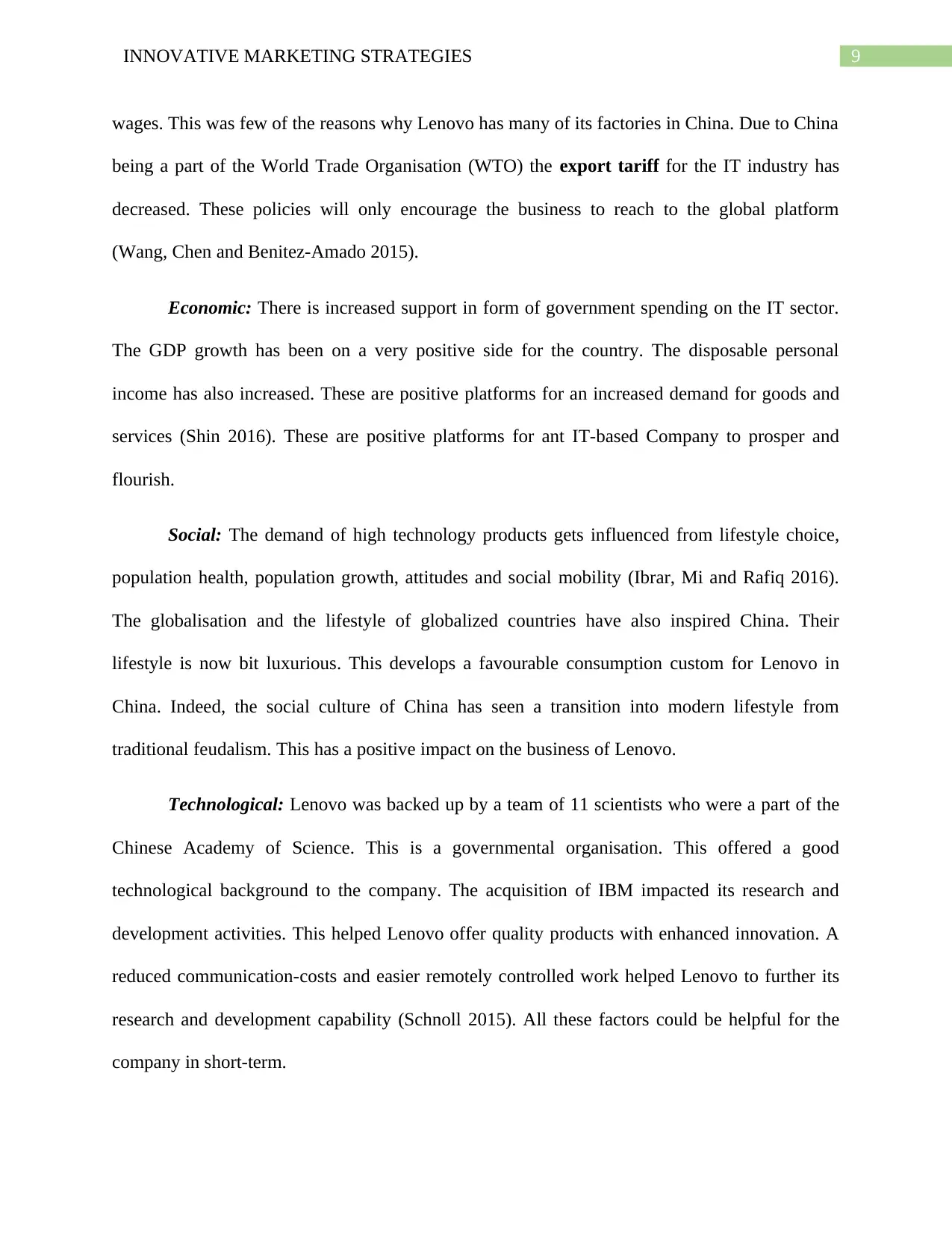
9INNOVATIVE MARKETING STRATEGIES
wages. This was few of the reasons why Lenovo has many of its factories in China. Due to China
being a part of the World Trade Organisation (WTO) the export tariff for the IT industry has
decreased. These policies will only encourage the business to reach to the global platform
(Wang, Chen and Benitez-Amado 2015).
Economic: There is increased support in form of government spending on the IT sector.
The GDP growth has been on a very positive side for the country. The disposable personal
income has also increased. These are positive platforms for an increased demand for goods and
services (Shin 2016). These are positive platforms for ant IT-based Company to prosper and
flourish.
Social: The demand of high technology products gets influenced from lifestyle choice,
population health, population growth, attitudes and social mobility (Ibrar, Mi and Rafiq 2016).
The globalisation and the lifestyle of globalized countries have also inspired China. Their
lifestyle is now bit luxurious. This develops a favourable consumption custom for Lenovo in
China. Indeed, the social culture of China has seen a transition into modern lifestyle from
traditional feudalism. This has a positive impact on the business of Lenovo.
Technological: Lenovo was backed up by a team of 11 scientists who were a part of the
Chinese Academy of Science. This is a governmental organisation. This offered a good
technological background to the company. The acquisition of IBM impacted its research and
development activities. This helped Lenovo offer quality products with enhanced innovation. A
reduced communication-costs and easier remotely controlled work helped Lenovo to further its
research and development capability (Schnoll 2015). All these factors could be helpful for the
company in short-term.
wages. This was few of the reasons why Lenovo has many of its factories in China. Due to China
being a part of the World Trade Organisation (WTO) the export tariff for the IT industry has
decreased. These policies will only encourage the business to reach to the global platform
(Wang, Chen and Benitez-Amado 2015).
Economic: There is increased support in form of government spending on the IT sector.
The GDP growth has been on a very positive side for the country. The disposable personal
income has also increased. These are positive platforms for an increased demand for goods and
services (Shin 2016). These are positive platforms for ant IT-based Company to prosper and
flourish.
Social: The demand of high technology products gets influenced from lifestyle choice,
population health, population growth, attitudes and social mobility (Ibrar, Mi and Rafiq 2016).
The globalisation and the lifestyle of globalized countries have also inspired China. Their
lifestyle is now bit luxurious. This develops a favourable consumption custom for Lenovo in
China. Indeed, the social culture of China has seen a transition into modern lifestyle from
traditional feudalism. This has a positive impact on the business of Lenovo.
Technological: Lenovo was backed up by a team of 11 scientists who were a part of the
Chinese Academy of Science. This is a governmental organisation. This offered a good
technological background to the company. The acquisition of IBM impacted its research and
development activities. This helped Lenovo offer quality products with enhanced innovation. A
reduced communication-costs and easier remotely controlled work helped Lenovo to further its
research and development capability (Schnoll 2015). All these factors could be helpful for the
company in short-term.
Paraphrase This Document
Need a fresh take? Get an instant paraphrase of this document with our AI Paraphraser
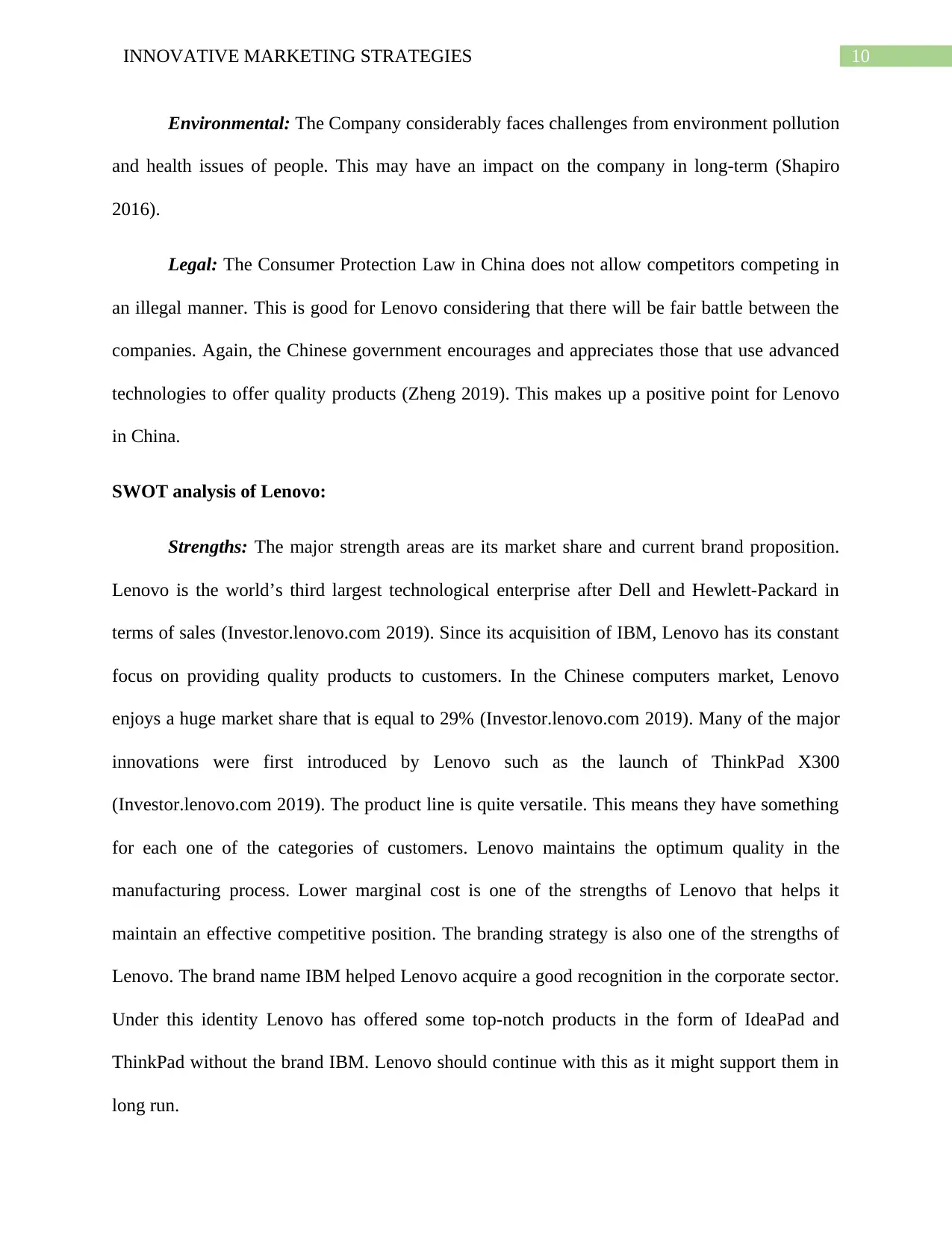
10INNOVATIVE MARKETING STRATEGIES
Environmental: The Company considerably faces challenges from environment pollution
and health issues of people. This may have an impact on the company in long-term (Shapiro
2016).
Legal: The Consumer Protection Law in China does not allow competitors competing in
an illegal manner. This is good for Lenovo considering that there will be fair battle between the
companies. Again, the Chinese government encourages and appreciates those that use advanced
technologies to offer quality products (Zheng 2019). This makes up a positive point for Lenovo
in China.
SWOT analysis of Lenovo:
Strengths: The major strength areas are its market share and current brand proposition.
Lenovo is the world’s third largest technological enterprise after Dell and Hewlett-Packard in
terms of sales (Investor.lenovo.com 2019). Since its acquisition of IBM, Lenovo has its constant
focus on providing quality products to customers. In the Chinese computers market, Lenovo
enjoys a huge market share that is equal to 29% (Investor.lenovo.com 2019). Many of the major
innovations were first introduced by Lenovo such as the launch of ThinkPad X300
(Investor.lenovo.com 2019). The product line is quite versatile. This means they have something
for each one of the categories of customers. Lenovo maintains the optimum quality in the
manufacturing process. Lower marginal cost is one of the strengths of Lenovo that helps it
maintain an effective competitive position. The branding strategy is also one of the strengths of
Lenovo. The brand name IBM helped Lenovo acquire a good recognition in the corporate sector.
Under this identity Lenovo has offered some top-notch products in the form of IdeaPad and
ThinkPad without the brand IBM. Lenovo should continue with this as it might support them in
long run.
Environmental: The Company considerably faces challenges from environment pollution
and health issues of people. This may have an impact on the company in long-term (Shapiro
2016).
Legal: The Consumer Protection Law in China does not allow competitors competing in
an illegal manner. This is good for Lenovo considering that there will be fair battle between the
companies. Again, the Chinese government encourages and appreciates those that use advanced
technologies to offer quality products (Zheng 2019). This makes up a positive point for Lenovo
in China.
SWOT analysis of Lenovo:
Strengths: The major strength areas are its market share and current brand proposition.
Lenovo is the world’s third largest technological enterprise after Dell and Hewlett-Packard in
terms of sales (Investor.lenovo.com 2019). Since its acquisition of IBM, Lenovo has its constant
focus on providing quality products to customers. In the Chinese computers market, Lenovo
enjoys a huge market share that is equal to 29% (Investor.lenovo.com 2019). Many of the major
innovations were first introduced by Lenovo such as the launch of ThinkPad X300
(Investor.lenovo.com 2019). The product line is quite versatile. This means they have something
for each one of the categories of customers. Lenovo maintains the optimum quality in the
manufacturing process. Lower marginal cost is one of the strengths of Lenovo that helps it
maintain an effective competitive position. The branding strategy is also one of the strengths of
Lenovo. The brand name IBM helped Lenovo acquire a good recognition in the corporate sector.
Under this identity Lenovo has offered some top-notch products in the form of IdeaPad and
ThinkPad without the brand IBM. Lenovo should continue with this as it might support them in
long run.
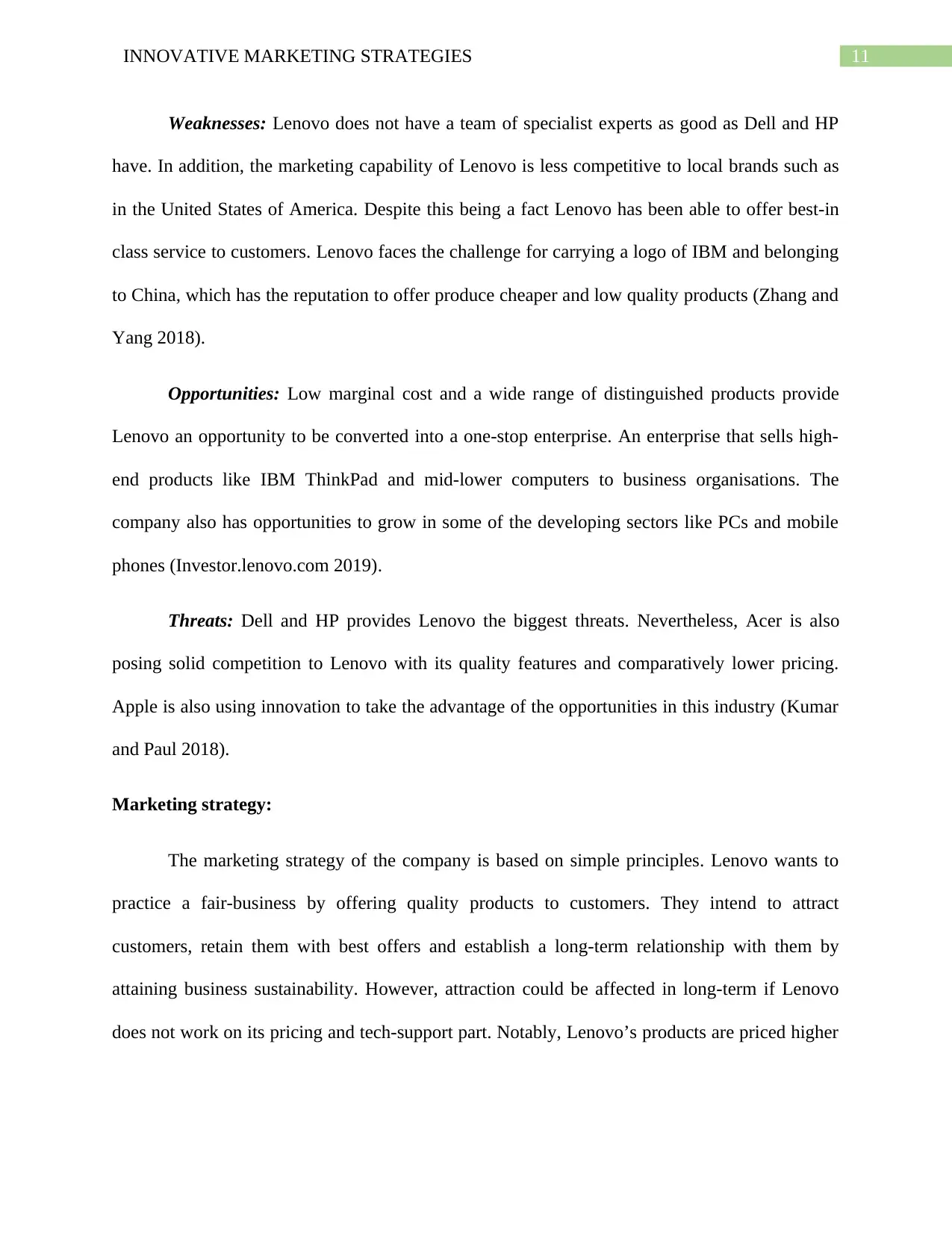
11INNOVATIVE MARKETING STRATEGIES
Weaknesses: Lenovo does not have a team of specialist experts as good as Dell and HP
have. In addition, the marketing capability of Lenovo is less competitive to local brands such as
in the United States of America. Despite this being a fact Lenovo has been able to offer best-in
class service to customers. Lenovo faces the challenge for carrying a logo of IBM and belonging
to China, which has the reputation to offer produce cheaper and low quality products (Zhang and
Yang 2018).
Opportunities: Low marginal cost and a wide range of distinguished products provide
Lenovo an opportunity to be converted into a one-stop enterprise. An enterprise that sells high-
end products like IBM ThinkPad and mid-lower computers to business organisations. The
company also has opportunities to grow in some of the developing sectors like PCs and mobile
phones (Investor.lenovo.com 2019).
Threats: Dell and HP provides Lenovo the biggest threats. Nevertheless, Acer is also
posing solid competition to Lenovo with its quality features and comparatively lower pricing.
Apple is also using innovation to take the advantage of the opportunities in this industry (Kumar
and Paul 2018).
Marketing strategy:
The marketing strategy of the company is based on simple principles. Lenovo wants to
practice a fair-business by offering quality products to customers. They intend to attract
customers, retain them with best offers and establish a long-term relationship with them by
attaining business sustainability. However, attraction could be affected in long-term if Lenovo
does not work on its pricing and tech-support part. Notably, Lenovo’s products are priced higher
Weaknesses: Lenovo does not have a team of specialist experts as good as Dell and HP
have. In addition, the marketing capability of Lenovo is less competitive to local brands such as
in the United States of America. Despite this being a fact Lenovo has been able to offer best-in
class service to customers. Lenovo faces the challenge for carrying a logo of IBM and belonging
to China, which has the reputation to offer produce cheaper and low quality products (Zhang and
Yang 2018).
Opportunities: Low marginal cost and a wide range of distinguished products provide
Lenovo an opportunity to be converted into a one-stop enterprise. An enterprise that sells high-
end products like IBM ThinkPad and mid-lower computers to business organisations. The
company also has opportunities to grow in some of the developing sectors like PCs and mobile
phones (Investor.lenovo.com 2019).
Threats: Dell and HP provides Lenovo the biggest threats. Nevertheless, Acer is also
posing solid competition to Lenovo with its quality features and comparatively lower pricing.
Apple is also using innovation to take the advantage of the opportunities in this industry (Kumar
and Paul 2018).
Marketing strategy:
The marketing strategy of the company is based on simple principles. Lenovo wants to
practice a fair-business by offering quality products to customers. They intend to attract
customers, retain them with best offers and establish a long-term relationship with them by
attaining business sustainability. However, attraction could be affected in long-term if Lenovo
does not work on its pricing and tech-support part. Notably, Lenovo’s products are priced higher
⊘ This is a preview!⊘
Do you want full access?
Subscribe today to unlock all pages.

Trusted by 1+ million students worldwide
1 out of 26
Related Documents
Your All-in-One AI-Powered Toolkit for Academic Success.
+13062052269
info@desklib.com
Available 24*7 on WhatsApp / Email
![[object Object]](/_next/static/media/star-bottom.7253800d.svg)
Unlock your academic potential
Copyright © 2020–2025 A2Z Services. All Rights Reserved. Developed and managed by ZUCOL.





